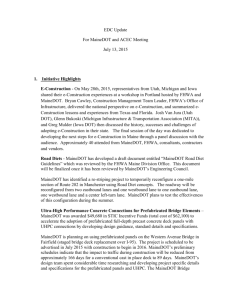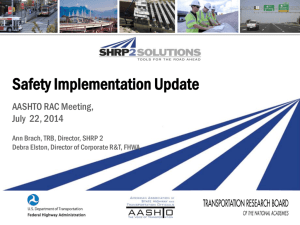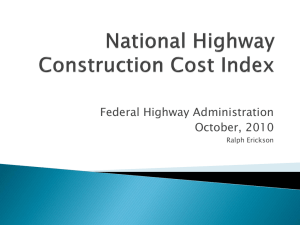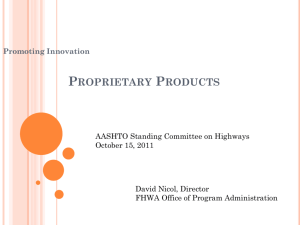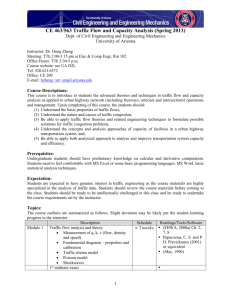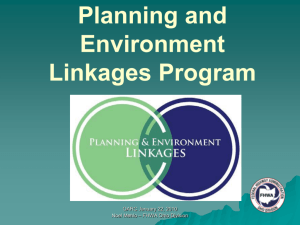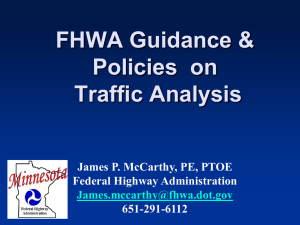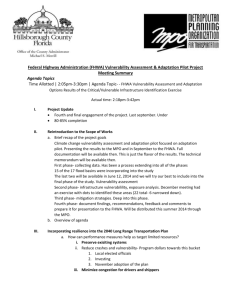Tool Kit for L06 Implementation Assistance_Version 1_April 2014
advertisement
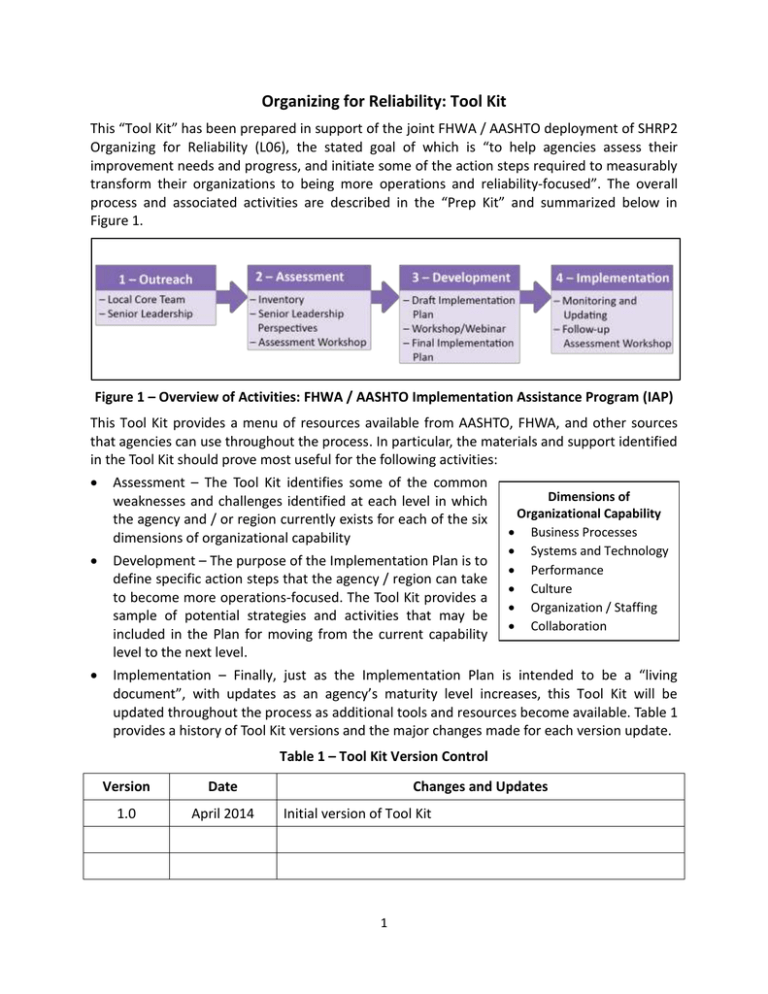
Organizing for Reliability: Tool Kit This “Tool Kit” has been prepared in support of the joint FHWA / AASHTO deployment of SHRP2 Organizing for Reliability (L06), the stated goal of which is “to help agencies assess their improvement needs and progress, and initiate some of the action steps required to measurably transform their organizations to being more operations and reliability-focused”. The overall process and associated activities are described in the “Prep Kit” and summarized below in Figure 1. Figure 1 – Overview of Activities: FHWA / AASHTO Implementation Assistance Program (IAP) This Tool Kit provides a menu of resources available from AASHTO, FHWA, and other sources that agencies can use throughout the process. In particular, the materials and support identified in the Tool Kit should prove most useful for the following activities: Assessment – The Tool Kit identifies some of the common weaknesses and challenges identified at each level in which the agency and / or region currently exists for each of the six dimensions of organizational capability Development – The purpose of the Implementation Plan is to define specific action steps that the agency / region can take to become more operations-focused. The Tool Kit provides a sample of potential strategies and activities that may be included in the Plan for moving from the current capability level to the next level. Implementation – Finally, just as the Implementation Plan is intended to be a “living document”, with updates as an agency’s maturity level increases, this Tool Kit will be updated throughout the process as additional tools and resources become available. Table 1 provides a history of Tool Kit versions and the major changes made for each version update. Dimensions of Organizational Capability Business Processes Systems and Technology Performance Culture Organization / Staffing Collaboration Table 1 – Tool Kit Version Control Version Date 1.0 April 2014 Changes and Updates Initial version of Tool Kit 1 Updates to the Tool Kit will be sent out as various tools, training courses, workshops, and other information sources – several of which are identified herein as “under development” – are finalized and as any new or additional tools are identified. Moreover, should any agency or member of the local core team know of a useful tool or resource that is not identified herein – perhaps one included in the Implementation Plan that would be beneficial to other agencies for moving from one level to the next – please contact Steve Clinger of FHWA at Stephen.Clinger@dot.gov. These additional tools will also be included in subsequent updates as appropriate. The initial item in the Tool Kit is a summary of the characteristics at each Level (1-4) for each of the six dimensions. This matrix is based on a combination of the materials being presented in the Assessment Workshops, and the matrix provided in the “One-Minute Guidance Evaluation” from the AASHTO website (http://www.aashtotsmoguidance.org/one_minute_evaluation/). The rest of the Tool Kit consists of 18 Tables – three for each of the six dimensions; from Level 1 to Level 2, from Level 2 to Level 3, and Level 3 to Level 4 – providing information and guidance for use by the local core team in developing the Implementation Plan. The format of the 18 tables is summarized in Table 2. The information contained herein is not meant to be prescriptive or complete. It is only a sample of potential action items, resources, and other tools that may be used to promote the mainstreaming of operations into the institutional framework. As noted above, updates identifying additional tools and resources will be sent out throughout the IAP process. 2 Table 2 – Tool Kit Format (For Advancing to the Next Level for Each Capability Dimension) Dimension – Level X to Level X+1 GOAL: The overall vision and end-point for achieving the next level. Common Challenges Identified at Level “N” Examples of common issues experienced at the current level in the context of making operations (TSMO) an integral part of an agency and/or the regional transportation planning process (i.e., “mainstreaming”). These examples are taken directly from previous assessment workshops. Potential Strategies and Actions to Move to the Next Level A sample list of potential tactics and action items to include in the Implementation Plan. These are based on the pertinent section from the AASHTO Systems Operations and Management Guidance website. This document was recently updated, and provides numerous potential action items that should be reviewed and considered for the Implementation Plan. The sample lists in the Tool Kit are only provided as an example. The specific action items need to be based upon and tailored to meet the unique characteristics and operations practices of the agency and region as may be identified from: The results and recommendations from the CMM assessment workshop (and any other operationsoriented workshops) and follow-up discussions. Review of location-specific documents (e.g., operations plans and procedures, regional plan, strategic plans, transportation improvement plans, Congestion Management Plans, Concepts of Operations, performance management plans, other planning and procedural documents, organization charts, position descriptions, inter-agency agreements) that may provide possible strategies and action items. 3 Possible Resources (not all inclusive) A non-inclusive list of potential peer exchanges regarding best practices, training courses and workshops, references and related tools, and other technical assistance from FHWA. With respect to peer exchanges, a number of agencies and / or regions are already functioning at higher levels of maturity. The collective experiences and lessons learned from these peer agencies with respect to mainstreaming operations may provide valuable information. Peer exchanges can involve a few conference calls, webinars, or face-to-face workshops depending on the needs and desires of the individual agency / region. In addition to the specific resources listed in the matrices, there are several tools that are applicable to nearly all dimensions, including: Workshops on Improving Business Processes for Traffic Incident Management, Planned Special Events, Work Zone Management, Road Weather Management, Traffic Management (under development) Regional Operations Forum (Under Development) National Operations Academy Specific FHWA staff with expertise in the particular dimension are also listed, plus a link to a website listing all of the FHWA Division offices. Summary of Characteristics for Each Level of Agency / Regional TSMO Capability Dimension Business Processes (Scoping, planning, programming, budgeting,) Systems & Technology (Systems engineering, systems architectures, standards and interoperability) Level 1 – Performed Each jurisdiction / agency within the region doing its own thing according to individual priorities and capabilities. Processes related to TSMO activities within individual agencies ad hoc and uncoordinated. Ad hoc approaches to system development and implementation without consideration of systems engineering Performance Measurement (Defining measures, data & analytics and utilization) Culture (Technical understanding, leadership, outreach, and program authority) Some TSMO-related outputs measured and reported by some jurisdictions. Organization / Workforce (Organizational structure, programmatic status, and staff development and retention) TSMO added on to units within existing organizational structure and staffing -dependent on technical champions. Individual staff champions promote TMSO – varying among jurisdictions. Level 2 – Managed Consensus regional approach developed regarding TSMO goals, operational objectives, needs, networks, and strategies with common priorities. Individual agencies have multi-year TSMO plans and programs. Regional and agency Concepts of Operations and architectures developed and documented; appropriate procurement process employed. Output –based measures for TSMO used for after-action debriefings and for identifying improvements; data easily available and dashboarded. Jurisdictions’ senior management understands operations business case and educates decision makers/public. Level 3 – Integrated Programming, budgeting, and project development processes for TSMO standardized and documented. Regional program integrated into jurisdictions’ overall multimodal transportation plans. Systems and technology standardized and integrated together on an agency and regional basis, with other related processes and training provided as appropriate. TSMO outcome measures identified and reported, and routinely by agencies for accountability and operations program justification. Jurisdictions’ mission statements include operations and benefits. TSMO a formal core program; achieves wide public visibility / understanding TSMO-specific organizational concept developed within / among jurisdictions, with core capacity needs identified. Top level management position and core staff for TSMO established. TSMO managers have direct report to top management; Job specs, certification and training for core positions exists. 4 Level 4 – Optimizing TSMO integrated into agencies’ and region’s multi-modal and multi-network plans and programs, based on a formal continuing regional planning process. TSMO is a formal, sustainable line item in agencies’ budgets, subject to continuous improvement. Systems, architectures and technology routinely assessed and upgraded to improve efficiency and performance. Systems interoperability maintained on continuing basis TSMO outcome measures incorporated into the regional transportation planning process as part of an objectives-driven performance based approach. Region-wide commitment to TSMO, and the associated mobility, safety, sustainability, and customer service benefits. TSMO accepted as formal, top-level core program of all agencies and MPO. Professionalization and certification of operations core capacity positions including performance incentives; career paths established. TSMO senior managers at equivalent level with other agency services, and staff professionalized. Dimension Collaboration (Relationships and partnerships among levels of government and with public safety agencies and private sector) Level 1 – Performed Level 2 – Managed Relationships informal, ad Regular meetings and hoc and on a personal basis collaboration at a regional (public-public, public-private) level. Operations objectives, strategies and performance measures aligned among agencies and key players (transportation and public safety agencies); joint afteraction debriefing routinely done. 5 Level 3 – Integrated Formalization of information sharing and operations responsibilities among key players thru co-training, formal agreements and incentives. Level 4 – Optimizing Significant level of formalized operations coordination among owner/operators (state, local, public safety, private) of all modes throughout the region on a daily recurring basis. Business Processes – Level 1 to Level 2 GOAL: Establish framework for suitable TSMO related planning and programming activities Common challenges identified at level 1 Lack of a formal TSMO plan TSMO not integrated into the planning and programming process No TSMO-specific budget line item No clear distinction between operations and maintenance in planning/expenditures Little/no consideration of evaluating trade-offs among investment decisions Implementation of supporting ITS technology typically added on to capital projects, leading to fragmentation of ITS infrastructure Potential strategies and actions to move to level 2 Possible Resources (not all inclusive) Potential actions identified in the AASHTO operations guide – for example: Establish a TSMO working group including agency operations and planning staff (district and central), and public safety; and hold regular meetings to review current state of planning and programming activities for TSMO deployment. – within the agency and regionally Develop business case for TSMO using existing performance data on project outcomes / benefits; and communicate to senior management and policymakers to gain support for agency approach to improved TSMO. Identify / document internal and external processes or process changes needed to implement operational concepts and strategies at the agency and regional levels, ensuring inclusion of TSMO options at all stages of project development. Develop agency TSMO Plan / Regional Concept of Operations Develop order-of magnitude costs estimates and timeframes for TSMO improvements for inclusion in agency budgets Develop procedures for incorporating TSMO infrastructure into other on-going roadway development activities Peer exchanges on best practices and examples from peer agencies Technical assistance from FHWA including assessments followed by a summary of observations and suggestions for improvement Training/Workshops: Workshops and forums identified in previous Table 2 Tools and Other Information Resources: Tool for Operations Benefit Cost Analysis DOT CEO slide presentation (long version for agency staff)) on importance of TSMO and associated benefits 6 Contacts: FHWA HQ/Resource center: Wayne Berman, Jim Hunt, Ralph Volpe, Ben Williams, Joe Gregory, Daniel Grate FHWA Division office Business Processes – Level 2 to Level 3 GOAL: Develop multiyear statewide TSMO plan and related process improvements Common challenges identified at level 2 Lack of an overall statewide or regional TSMO strategic plan While a multiyear TSMO plan and program have been developed and are supported by senior agency managers, they have not been fully or formally incorporated into the established statewide DOT planning and / or regional planning processes for programming and budgeting. MPO Board and senior MPO staff lack full appreciation of TSMO benefits Long Range Regional Transportation Plan and Congestion Management Plan do not fully address TSMO strategies Potential strategies and actions to move to level 3 Possible Resources (not all inclusive) Potential actions identified in the AASHTO operations guide – for example: Expand TSMO working group (from previous level) to include other agencies (e.g., local, transit, freight) and MPO, focusing on integrating TSMO into the regional and statewide transportation planning processes Develop a regional / statewide TSMO plan (e.g., based on agency TSMO plans and Regional CONOPS), including appropriate objectives, policy needs, and estimated project costs and benefits. Include multi-agency projects along priority corridors (e.g., ICM) in the plan. Develop an objectives-driven, performance based approach to identify and prioritize TSMO strategies and projects (incorporating performance measures and benefitcost outcomes). Also refer to Performance Management dimension Develop multi-year statewide TSMO program and budget Incorporate TSMO projects and budgets (e.g., from statewide / regional TSMO Plan) into the statewide / regional transportation improvement plans and long-range plans. Establish a standard procedure in overall agency and regional project development processes to incorporate TSMO strategies and supporting ITS components into new projects Update and modify the project development and procurement process to incorporate TSMO projects Peer exchanges on best practices and examples from peer agencies Technical assistance from FHWA including assessments followed by a summary of observations and suggestions for improvement Training/Workshops: A Workshop for Integrating Planning for Operations into MPO plans and programs Advancing Planning for Operations in Metropolitan Areas (NHI 133111) Implementing an Effective Congestion Management Process as Part of Performance-Based Planning Workshops and forums identified in previous Table 2 7 Tools and Other Information Resources: Regional Concept for Transportation Operations Advancing Metropolitan Planning for Operations: An Objectives-Driven, Performance-Based Approach – A Guidebook Other Materials from FHWA Planning for Operations website MPO CEO slide presentation Regional Operations in the 21st Century; A Vital Role for MPOs Contacts: FHWA HQ/Resource center: Wayne Berman, Jim Hunt, Ralph Volpe, Ben Williams, Joe Gregory, Daniel Grate FHWA Division office Business Processes – Level 3 to Level 4 GOAL: Integrate new operations objectives and processes into department activities as formalized standard operating procedures. Common challenges identified at level 3 Having fully achieved Level 3, the challenge is to institutionalize (i.e., “mainstream”) the processes such that they provide a stable and replicable basis for continuous improvement, regardless of any changes in staffing at the DOT or MPO. Incorporating new TSMO strategies (ATDM) multi-modal approaches (ICM) and technologies (Connected Vehicles) into the statewide TSMO plan and regional plans. Updating performance measures and metrics to reflect new TSMO strategies and lessons learned from other TSMO deployments Potential strategies and actions to move to level 4 Possible Resources (not all inclusive) Potential actions identified in the AASHTO operations guide – for example:: Develop and document a process to regularly review and update (e.g., every 2-3 years) the Statewide and Regional TSMO plans, regional concept of operations, ITS architectures, etc.), identifying lead agency and stakeholder responsibilities. Track emerging TSMO strategies and supporting ITS technologies in the context of how they may help achieve regional objectives Develop approaches and update planning / budgeting procedures as appropriate to incorporate new strategies and technologies Working with other regional stakeholders, propose on USDOT model deployment and related projects to showcase and demonstrate (e.g., test bed) new TSMO strategies and supporting technologies Develop process for regularly performing investment trade-offs among capacity vs. TSMO improvements vs. on-going operations and maintenance as part of the regular budgeting cycle Investigate innovative financing opportunities (public – private partnerships, cost-sharing with other agencies) Incorporate TSMO and supporting ITS into asset management processes. Peer exchanges on best practices and examples from peer agencies Technical assistance from FHWA including assessments followed by a summary of observations and suggestions for improvement Training/Workshops: Workshops and forums identified in previous Table 2 Tools and Other Information Resources: MPO and DOT CEO slide presentations on importance of TSMO and associated benefits (for new managers) 8 Contacts: FHWA HQ/Resource center: Wayne Berman, Jim Hunt, Ralph Volpe, Ben Williams, Joe Gregory, Daniel Grate FHWA Division office Systems and Technology – Level 1 to Level 2 GOAL: Introduce systems engineering into project development processes Common challenges identified at level 1 Regional ITS architecture out of date (e.g., doesn’t reflect recent updates to the National ITS Architecture) Systems engineering is not an integral part of the project development process Potential strategies and actions to move to level 2 Possible Resources (not all inclusive) Potential actions identified in the AASHTO operations guide – for example: Establish architecture review committee and provide architecture training for key committee staff. Review and updated the regional ITS architecture (by the committee or by others under the committee’s direction) to reflect the latest version of the National Architecture and recent / planned TSMO deployments Identify and document the data and information sharing needs within the region (between agencies and within DOT) in support of regional ITS architecture Present the “business case” and develop a plan for regularly reviewing, maintaining and updating the regional architecture Develop an agency-wide policy that requires the use of systems engineering for the procurement of new systems and the enhancement of existing systems utilizing advanced technology. Include a process defining the systems engineering steps to be executed at each stage of the project development and deployment process. Provide systems engineering training for key agency staff involved in the project development and deployment process. Identify and document relevant standards for TSMO within the agency and include in the system design process and procedures Peer exchanges on best practices and examples from peer agencies. Technical assistance from FHWA including assessments followed by a summary of observations and suggestions for improvement Training/Workshops: Regional Architecture Use and Maintenance Workshop/Seminar Turbo Architecture-Web-Based – (NHI-137048) Introduction to the National ITS Architecture Web Based Introduction to Systems Engineering Web-Based CITE Certificate Program – ITS Project Management (e.g., Intro to Systems Engineering) and ITS System(e.g., ITS System Architecture and Standards) Workshops and forums identified in previous Table 2 9 Tools and Other Information Resources: Regional ITS Architecture Guidance Systems Engineering Guidebook Contacts: Kingsley Azubike, Rick Denney, Paul Olson, Nathaniel Price, Joe Gregory, Daniel Grate FHWA Division office Systems and Technology – Level 2 to Level 3 GOAL: Develop and implement tools and procedures to support standardized systems engineering processes and information sharing throughout the region. Common challenges identified at level 2 Lack of data sharing across modes (transit) or at the arterial level (traffic signals) Data sharing between agencies not formalized Interoperability challenges among agencies IT department approval processes Insufficient IT resources Lack of consistent approach to system / technology procurement and maintenance Potential strategies and actions to move to level 3 Possible Resources (not all inclusive) Potential actions identified in the AASHTO operations guide – for example: Develop and implement a configuration management process for reviewing proposed changes to the Regional Architecture, adopted standards, and systems engineering / project development activities. Engage and build relationships with IT staff on the purpose and benefits of TSMO projects; develop and document strategies and processes for better communications and timely reviews of TSMO-related documents Develop a plan identifying systems and standards to facilitate statewide/regional interoperability Establish / formalize data sharing platform and protocols between systems and agencies (regional and statewide) Identify and define rules (in addition to standards) for promoting interoperability between agencies (e.g., when command and control of devices may be shared) Ensure budgets for continued training of TSMO and systems engineering staff, and for long-term operations and maintenance support of the regional data sharing system are included in the statewide TSMO plan and regional plans (Refer to “Business Processes” dimension) Peer exchanges on best practices and examples from peer agencies Technical assistance from FHWA including assessments followed by a summary of observations and suggestions for improvement Training/Workshops: Advanced Systems Engineering for Advanced Transportation Projects – Web Based Systems Engineering Process Improvement Review Workshops Interoperability: ITS System Architecture and Standards Web-based CITE Certificate Program – ITS Project Management (e.g., Configuration Management) and ITS System(e.g., Fundamentals of Database Management Systems) Workshops and forums identified in previous Table 2 10 Tools and Other Information Resources: “Configuration Management for Transportation Management Systems – A Primer” Contacts: Kingsley Azubike, Rick Denney, Paul Olson, Nathaniel Price, Joe Gregory, Daniel Grate FHWA Division office Systems and Technology – Level 3 to Level 4 GOAL: Coordinate and update architecture and regional interoperability activities with new systems / technologies and performance measurement on a continuing basis. Common challenges identified at level 3 Having fully achieved Level 3, the challenge is to institutionalize (i.e., “mainstream”) the processes such that they provide a stable and replicable basis for continuous improvement, regardless of any changes in staffing at the DOT or MPO. Incorporating new TSMO strategies (ATDM), multi-modal approaches (ICM) and technologies (Connected Vehicles) into the regional architecture, interoperability process, and associated standard plans. Linking the architecture and systems engineering-related processes to TSMO objectives and performance measures. Potential strategies and actions to move to level 4 Possible Resources (not all inclusive) Potential actions identified in the AASHTO operations guide – for example: Monitor ongoing developments in TSMO and supporting ITS technologies, as well as updates to the National ITS Architecture, and update the regional architecture and interoperability agreements accordingly (in accordance with the established architecture maintenance plan and configuration management processes) Review and update the regional ITS architecture to support the collection of data for performance measurement Implement a training program for all new staff introducing them to the regional ITS architecture, systems engineering process, inter-agency information sharing, configuration management, etc. Develop a certification process for individuals involved with system development, operation and maintenance to ensure that they are qualified to participate in the process Peer exchanges on best practices and examples from peer agencies Technical assistance from FHWA including assessments followed by a summary of observations and suggestions for improvement Training/Workshops: 11 Tools and Other Information Resources: Applying a Regional ITS Architecture to Support Planning for Operations: A Primer CITE Certificate Program – selected courses as appropriate for new staff Workshops and forums identified in previous Table 2 Contacts: Kingsley Azubike, Rick Denney, Paul Olson, Nathaniel Price, Joe Gregory, Daniel Grate FHWA Division office Performance Measurement – Level 1 to Level 2 GOAL: Identify output performance measures for selected TSMO activities Common challenges identified at level 1 TSMO-related performance measures not clearly identified or defined Performance measurement and data collection / utilization implemented only on an ad hoc or project basis Non-existent/inadequate external performance reporting (Dashboard) Potential strategies and actions to move to level 2 Possible Resources (not all inclusive) Potential actions identified in the AASHTO operations guide – for example: Identify and document appropriate output performance measures for current and near-term TSMO strategies. This effort should be coordinated with those being developed by FHWA in accordance with MAP 21 Determine potential targets and related metrics and statistics for the output performance measures. Relate the targets to key audiences, including technical and nontechnical groups. , and groups defined by information needs, time, and locations. Determine current TSMO performance (using output measures) from data that are already being collected and archived. Create standard performance report including dashboards, for internal use that will identify trends in performance so that specific problems can be targeted. Peer exchanges on best practices and examples from peer agencies. Technical assistance from FHWA including assessments followed by a summary of observations and suggestions for improvement Training/Workshops: Operations Performance Measures Workshop Performance Measures – Web-Based (CITE) Workshops and forums identified in previous Table 2 Note – Output measures include information on the efficiency with which resources are transformed into goods and services (i.e., outputs) and the quality of those outputs (how well they are delivered to clients and the extent to which clients are satisfied) 12 Tools and Other Information Resources: FHWA Transportation Performance Management website Performance Measurement Fundamentals WSDOT performance measurement library Performance Measurement Exchange Community of Practice (CoP) Website Examples of Performance Measurement Programs Freight performance measurement web tool Contacts: FHWA HQ/Resource center: PM - Rich Taylor, Ralph Volpe, Wayne Berman, Joe Gregory, Daniel Grate; Realtime system mgmt.: Bob Rupert, Ray Murphy FHWA Division office Performance Measurement – Level 2 to Level 3 GOAL: Identify output performance measures for all TSMO activities, and develop data collection and management plan to support utilization of all performance measures Common challenges identified at level 2 TSMO-related performance measures are primarily outputbased, with relatively few outcome-based measures (e.g., reliability) Performance measures are not related to or used to track progress toward TSMO goals and objectives Minimal customerfocused performance measures Data collection and management process in support of performance measurement not formalized Potential strategies and actions to move to level 3 Possible Resources (not all inclusive) Potential actions identified in the AASHTO operations guide – for example: Identify and document appropriate outcome performance measures for TSMO strategies. This effort should be coordinated with those being developed by FHWA in accordance with MAP 21. Link the outcome measures to operations-related goals and objectives within the agency (as part of an objectivesdriven, performance based approach for identifying and prioritizing TSMO strategies (refer to “Business Processes” dimension). Integrate the outcome measures with the output measures into a comprehensive and documented performance management program for operations, including enhanced reporting methods and dashboards.. Determine potential targets and related metrics for the performance measures and associated accountability. Relate the targets and accountability to key audience groups. Develop a data collection and management business plan for collection, integration, management, reporting and application of performance measures. The plan should identify opportunities for multipurpose data acquisition and the use of third party data (public and private). Note – Outcome measures focus on the results of a program activity compared to its intended purpose, and the effectiveness of operations in terms of their specific contributions to program objectives. Outcome measures should address reliability and sustainability (and others) in addition to mobility and safety. Peer exchanges on best practices and examples from peer agencies Technical assistance from FHWA including assessments followed by a summary of observations and suggestions for improvement Training/Workshops: Operations Performance Measures Workshop Performance Measures – Web-Based (CITE) Workshops and forums identified in previous Table 2 Tools and Other Information Resources: “Incorporating Reliability Performance Measures into the Transportation Planning and Programming Processes: Technical Reference” (SHRP 2 L05) FHWA website reliability-based performance measures FHWA Transportation Performance Management website Performance Measurement Fundamentals WSDOT performance measurement library Performance Measurement Exchange Community of Practice (CoP) Website Examples of Performance Measurement Programs 13 Contacts: FHWA HQ/Resource center: PM - Rich Taylor, Ralph Volpe, Wayne Berman, Joe Gregory, Daniel Grate; Realtime system mgmt.: Bob Rupert, Ray Murphy FHWA Division office Performance Measurement – Level 3 to Level 4 GOAL: Mission-related outputs/outcomes integrated into the regional transportation planning process, with the data routinely reported internally and externally and archived, and utilized for management across all transportation agencies within the region. Common challenges identified at level 3 Having fully achieved Level 3, the challenge is to institutionalize (i.e., “mainstream”) the performance management process and integrate it into a regional objectivesdriven, performance based approach for identifying and prioritizing TSMO strategies within the regional transportation plan and CMP (refer to “Business Processes” dimension), followed by on-going evaluations of the implemented TSMO strategies Lack of common performance measures across multiple jurisdictions and modes within the region Data for performance management not systematically archived, including quality control. Potential strategies and actions to move to level 4 Possible Resources (not all inclusive) Potential actions identified in the AASHTO operations guide – for example: Identify performance measures from a corridor / system wide perspective (e.g., “mode-neutral” performance measures) Extend outcome measurement program to support broader (non-mobility, non-safety) regional goals that may emerge, including environmental (e.g., greenhouse gas generation), climate change adaptation, livability (e.g., generic origindestination travel times), and land use. Design and implement a regional Archived Data Management System to facilitate the production of operations performance measures and to provide data for other applications. Develop data quality assurance program. Routinely evaluate newly deployed projects and changes in policies from a regional perspective using the performance measurement system. Establish common performance terminology, definitions, and analytics across jurisdictions Peer exchanges on best practices and examples from peer agencies Technical assistance from FHWA including assessments followed by a summary of observations and suggestions for improvement Training/Workshops: Workshops and forums identified in previous Table 2 Tools and Other Information Resources: Advancing Metropolitan Planning for Operations: An Objectives-Driven, Performance-Based Approach – A Guidebook The Washington State Department of Transportation Accountability & Performance Program Guidelines for Developing ITS Data Archiving Systems (http://tti.tamu.edu/documents/2127-3.pdf) FHWA Traffic Data Quality Measurement Final Report (http://ntl.bts.gov/lib/jpodocs/repts_te/14058.htm) Contacts: FHWA HQ/Resource center: PM - Rich Taylor, Ralph Volpe, Wayne Berman, Joe Gregory, Daniel Grate; Real-time system mgmt.: Bob Rupert, Ray Murphy FHWA Division office 14 Culture – Level 1 to Level 2 GOAL: Develop business case for TSMO and continuous improvement for operation performance leading to Agency-wide appreciation of the value and role of TSMO Common challenges identified at level 1 TSMO program dependent on staff champions Lack of understanding / appreciation for TSMO strategies and associated benefits by senior agency management and policy makers Potential strategies and actions to move to level 2 Possible Resources (not all inclusive) Potential actions identified in the AASHTO operations guide – for example: Develop and implement a strategy to familiarize agency leadership and staff with TSMO and how it can help the agency meet today’s challenges Identify existing processes and mechanisms for TSMO to be elevated, incorporated or considered within the agency. Develop internal visions or “stories: of TSMO benefits (including B/C ratios) leveraging past successes (e.g., major events) and national best practice. Develop and distribute a business case for incorporating TSMO strategies and supporting ITS technologies within the overall agency program, including improved customer service and overall performance. Identify potential events (major weather or emergencies, special events), analyze their issues and vulnerability, and prepare TSMO contingency plans including “what we could do if we were properly equipped/organized” concepts. Make the case to decision-makers regarding the components of response that would benefit from more formal day-to-day TSMO infrastructure and capabilities. Identify existing constraints (e.g., legal, administrative, interagency, institutional) to the effective application of TSMO strategies, and develop a plan for resolving them. Develop existing traveler information in a form of direct use to travelers (e.g., social media) Peer exchanges on best practices and examples from peer agencies. Technical assistance from FHWA including assessments followed by a summary of observations and suggestions for improvement Training/Workshops: Workshops and forums identified in previous Table 2 Tools and Other Information Resources: The 21st Century Operations Oriented State DOT Business Case Primer Uses of Social Media in Public Transportation DOT CEO slide presentation “Operations in the 21st Century DOT – Meeting Customer’s Needs and Expectations 15 Contacts: FHWA HQ/Resource center: Joe Gregory, Daniel Grate FHWA Division office Culture – Level 2 to Level 3 GOAL: Establish TSMO with a formal core business program status equivalent to other major programs Common challenges identified at level 2 Lack of understanding/ appreciation from legislature/ governor for TSMO strategies/ program Lack of publicity/outreach promoting TSMO benefits resulting from agency actions in deploying strategies Focus on capital project delivery and outcomes; capital projects dominate agency public outreach Challenge with appropriate / consistent terminology related to TSMO Potential strategies and actions to move to level 3 Possible Resources (not all inclusive) Potential actions identified in the AASHTO operations guide – for example: Develop a Business Case Action Plan for expanding current agency operations beyond freeways to include arterials and other modes for integrated corridors. Include potential future developments such as connected vehicles, automated and predictive traffic management, automated vehicles, mileage-based road usage charges, etc. Develop adjustments and changes to the formal agency mission, vision, and /or goals to incorporate operations. Present to senior management for adoption. Develop a plan for revising the agency organization as appropriate to accommodate formal program status for TSMO. The plan should identify existing constraints (legal, administrative, interagency) to full formal program status. Present to senior management for adoption. Develop outreach program to familiarize key stakeholder constituencies (freight, safety, legislative) of the importance and relevance of TSMO Maximize exposure of the agency TSMO program and benefits utilizing full range of communications (e.g., agency website), including “stories” such as past TSMO successes Align agency public relations strategies with TSMO program, including branding, terminology, and mechanisms (e.g., social media) for two-way communication and feedback with public and key system users. Peer exchanges on best practices and examples from peer agencies Technical assistance from FHWA including assessments followed by a summary of observations and suggestions for improvement Training/Workshops: Workshops and forums identified in previous Table 2 Tools and Other Information Resources: Business Case Primer Engaging Legislators in the Transportation Operations Message Glossary of Regional Transportation Systems Management and Operations Terms (from TRB) The 21st Century Operations Oriented State DOT Uses of Social Media in Public Transportation 16 Contacts: FHWA HQ/Resource center: Joe Gregory, Daniel Grate FHWA Division office Culture – Level 3 to Level 4 GOAL: Rationalize TSMO program development with other programs on basis of service-related cost-effectiveness; at both the agency and regional level Common challenges identified at level 3 Having fully achieved Level 3, the challenge is to institutionalize (i.e., “mainstream”) the TSMO program development process within the agency for continuous improvement. It is also important to integrate this TSMO culture into the broader regional planning process (refer to the “Business Processes” dimension, particularly in terms of the objectives-driven, performance based approach for identifying and prioritizing TSMO strategies within the regional transportation plan and CMP) Greater emphasis on customer service orientation Potential strategies and actions to move to level 4 Possible Resources (not all inclusive) Potential actions identified in the AASHTO operations guide – for example: Integrate concept of “continuous improvement” into agency management as a crosscutting process, including process of TSMO capability improvement based on performance Introduce TSMO into DOT / MPO policy, programming and budgeting as a key focus (refer to “Business Processes” dimension) Link TSMO program development with performance measurement process at the agency and regional levels(refer to “Performance Measurement” dimension) Peer exchanges on best practices and examples from peer agencies Technical assistance from FHWA including assessments followed by a summary of observations and suggestions for improvement Training/Workshops: Workshops and forums identified in previous Table 2 Tools and Other Information Resources: Getting the Most from Your Transportation System Investments Materials from FHWA Planning for Operations website (http://plan4operations.dot.gov/) Advancing Metropolitan Planning for Operations: An Objectives-Driven, Performance-Based Approach – A Guidebook MPO CEO slide presentation Regional Operations in the 21st Century; A Vital Role for MPOs Contacts: FHWA HQ/Resource center: Joe Gregory, Daniel Grate FHWA Division office 17 Organization and Workforce – Level 1 to Level 2 GOAL: Identify needed adjustments to organizational structure, staffing roles and responsibilities in support of TSMO Common challenges identified at level 1 TSMO program dependent on staff champions and personal relationships Fragmentation of TSMO responsibilities among different entities and locations within agency No formal TSMO position descriptions TSMO KSAs do not match standard position titles Limited/no formal training programs for TSMO staff Potential strategies and actions to move to level 2 Possible Resources (not all inclusive) Potential actions identified in the AASHTO operations guide the – for example: Identify current TSMO organizational structure(s)/ chain(s) of command and the relative hierarchy with other agency programs Define the features needed for full TSMO program status within the agency in terms of organizational structure and staffing. Develop staged strategy to move TSMO activities and related units (ITS design, TMCs, ITS maintenance, incident management, work zone management, etc.] from functional status to full program status. Document the above activities in an “organizational concept of operations,” including the business case for reorganization / increased staffing (e.g., benefits, consequences of staffing shortfalls / fragmented TSMO) Identify “core capacities” that are essential to building and managing TSMO activities, including their associated knowledge, skills, and abilities (KSAs) Develop position descriptions for each position including required KSAs position title, civil service classification, function and purpose of position, reporting relationships, general tasks, and decisions related to duties. Evaluate existing staff in terms of KSAs for their positions and identify gaps Identify training opportunities for key staff and develop training program identifying topics and required funding. Peer exchanges on best practices and examples from peer agencies. Technical assistance from FHWA including assessments followed by a summary of observations and suggestions for improvement Training/Workshops: ITE Professional Traffic Operations Engineer Certification Selected courses and electives from CITE Certificate Program – Traffic Engineering and Operations Workshops and forums identified in previous Table 2 18 Tools and Other Information Resources: NCHRP 20-77 Transportation Operations Framework Attracting, Recruiting, and Retaining Skilled Staff for Transportation System Operations and Management: (NCHRP Report 693) Attracting, Recruiting, and Retaining Skilled Staff for Transportation System Operations and Management – Executive Workbook FHWA TMC Operator Requirements and Position Descriptions Contacts: FHWA HQ/Resource center: Grant Zammit, Steve Clinger, Joe Gregory, Daniel Grate FHWA Division office Organization and Workforce – Level 2 to Level 3 GOAL: Integrate TSMO organization and staff into overall agency structure and clarify reporting relationships, coupled with staff training and retention measures Common challenges identified at level 2 Operations manager many levels down the organization chart No clear career paths or for TSMO staff advancement No clear process for TSMO organization / individuals staff accountability or recognition of superb performance Providing necessary training for TSMO staff to further skills and opportunities for advancement Sending TSMO staff to conferences and national forums Staff retention, turnover, and recruitment Potential strategies and actions to move to level 3 Possible Resources (not all inclusive) Potential actions identified in the AASHTO operations guide – for example: Integrate TSMO organization and staff into overall agency structure and clarify reporting relationships (in accordance with the plan / operational concept previously developed). Identify and resolve issues regarding position descriptions, related KSAs and existing agency and state position descriptions Develop and document case for top level organizational status as a formal core program in support of the agency mission. Establish training requirements and training schedule for key positions. Expand training program to include technical as well as management personnel at all levels Identify key staff to participate in national forums such as AASHTO, ITS America TRB, ITE, IEEE, etc. Encourage senior agency executives to participate as well. Include staff training and conference attendance in the TSMO budget (refer to “Business Processes” dimension). Develop a retention strategy for TSMO staff including enhanced training, working conditions, professional development, and performance bonuses. Link TSMO group / staff accountability to TSMO-related performance measures and metrics (refer to “Performance Measurement” dimension) Peer exchanges on best practices and examples from peer agencies Technical assistance from FHWA including assessments followed by a summary of observations and suggestions for improvement Training/Workshops: Selected courses and electives from CITE Certificate Program-ITS Project Management and ITS Systems Workshops and forums identified in previous Table 2 19 Tools and Other Information Resources: NCHRP 20-77 Transportation Operations Framework Attracting, Recruiting, and Retaining Skilled Staff for Transportation System Operations and Management: (NCHRP Report 693) Attracting, Recruiting, and Retaining Skilled Staff for Transportation System Operations and Management – Executive Workbook Contacts: FHWA HQ/Resource center: Grant Zammit, Steve Clinger, Joe Gregory, Daniel Grate FHWA Division office Organization and Workforce – Level 3 to Level 4 GOAL: Create a management and organizational structure for TSMO equivalent to that of other major agency programs Common challenges identified at level 3 Having fully achieved Level 3, the challenge is to institutionalize (i.e., “mainstream”) the TSMO organizational structure and workforce development activities, including performance incentives, within the agency to promote continuous improvement. In some cases, this may mean elevating the TSMO organization to the same level within the organization as the other formal core programs. It is also important that this mainstreaming be accomplished, with appropriate and defined links and lines of responsibility, at the headquarters and district / division DOT offices. Potential strategies and actions to move to level 4 Possible Resources (not all inclusive) Potential actions identified in the AASHTO operations guide – for example: Establish top level executive position for TSMO with fulltime program responsibility and direct reporting to Director/CEO, with equivalent positions in districts as appropriate to the agency Establish complete professionalization of TSMO positions, including certification, performance incentives, and establishment of clear, attractive career paths On-going review and adjustment to the organizational framework and staffing hierarchy (and performance incentives) to reflect new TSMO strategies and technologies, and any new skills and staffing associated with these strategies, as they are adopted and implemented by the agency. Annual review and update of succession plans as may be appropriate Peer exchanges on best practices and examples from peer agencies Technical assistance from FHWA including assessments followed by a summary of observations and suggestions for improvement Training/Workshops: Workshops and forums identified in previous Table 2 Tools and Other Information Resources: Contacts: FHWA HQ/Resource center: Grant Zammit, Steve Clinger, Joe Gregory, Daniel Grate FHWA Division office 20 Collaboration – Level 1 to Level 2 GOAL: Establish formal mechanisms for regular coordination and cooperation Common challenges identified at level 1 Relationships with other groups and agencies on an informal, ad hoc and personal basis No ongoing, multiagency (or multijurisdictional) group focused on regional operations (e.g., incident management. signal coordination across jurisdiction boundaries, freeway / arterial diversions ) Limited collaboration between operators and planners (in agency and with MPO) Limited collaboration with private sector Potential strategies and actions to move to level 2 Possible Resources (not all inclusive) Potential actions identified in the AASHTO operations guide the – for example: Establish relationships with fire, police, emergency management and other responders and agree to regular meetings aimed at improving processes—with initial focus on emergency response and incident management Develop a plan for improving communications (voice and data) and interoperability between transportation agencies and first responders, including sharing of DOT cameras and police computer-aided dispatch (CAD) information. Identify key procedures and protocols, and clarify, document and train for roles and responsibilities (i.e., field and centers) for all key participants during incident and emergency management activities. Conduct appropriate training, drills and tabletop exercises to test and improve concepts and protocols, and to familiarize personnel with roles and procedures. Establish collaborative mechanism (e.g., committees / forums, with regular meetings) to promote interagency dialogue regarding TSMO – between DOT,, other transportation agencies (local and transit) and regional planning organizations. Potential areas may include Integrated Corridor Management, traveler information, special event management, construction coordination, etc. Identify TSMO activities that may lend themselves to outsourcing and/or hybrid staffing, reviewing the pros and cons, and life-cycle costs, of leveraging private sector resources and outsourcing functions Peer exchanges on best practices and examples from peer agencies. There is also the Traffic Incident Management (TIM) & Planned Special Events (PSE) Peer-to-Peer Program 21 Technical assistance from FHWA including assessments followed by a summary of observations and suggestions for improvement Training/Workshops: National Traffic Incident Management Responder Training Program Workshops and forums identified in previous Table 2 Tools and Other Information Resources: Simplified Guide to the Incident Command System Traffic Incident Management Outreach Toolkit State DOT Outsourcing and Private-Sector Utilization Procuring, Managing, and Evaluating the Performance of Contracted TMC Services Regional Transportation Operations Collaboration and Coordination: A Primer for Working Together to Improve Transportation Safety, Reliability, and Security (FHWA) Contacts: FHWA HQ/Resource center: Incident/emergency mgmt.: Paul Jodoin, Jim Austrich, Laurie Radow, Kim Vasconez; MPO: Wayne Berman, Ralph Volpe FHWA Division office Collaboration – Level 2 to Level 3 GOAL: Execute formal interagency agreements for cooperative approach and definition of inter-agency roles and responsibilities. Common challenges identified at level 2 No formal agreements / out-of-date agreements with other agencies No formal process for debriefs following major incidents / special events Lack of common performance measures or incentives for collaborating Lack of project integration in region Lack of joint formalized training in specific areas requiring multi-agency coordination (e.g., incident management training with emergency service providers Lack of common notification protocols for incidents, operational changes, etc. Many local jurisdictions, transportation agencies, and emergency service providers for data sharing Potential strategies and actions to move to level 3 Possible Resources (not all inclusive) Potential actions identified in the AASHTO operations guide – for example: Develop and execute formal interagency agreements with police and other first responders to develop cooperative approach to TSMO, including formal interagency working group, protocols, data sharing, joint training, etc., in support of emergency and incident management. Establish a major incident and emergency debriefing process for review and updating of responsibilities and procedures as documented in formal agreements. This includes defining what constitutes a “major” incident and developing a procedure for convening and conducting debriefings and managing follow-up. Support integration of TSMO considerations into regional plans and budgeting documents. (Refer to Business Processes dimension) Identify and develop inter-agency / regional cooperative projects (e.g., information sharing, ICM, transit use of hard shoulder running / managed lanes) and associated inter-agency agreements in support of such programs and projects. Develop joint agreements regarding performance measurement and related process improvement approaches with respect to regional operations (refer to Performance Measurement dimension) Develop policy on outsourcing as appropriate Peer exchanges on best practices and examples from peer agencies. There is also the Traffic Incident Management (TIM) & Planned Special Events (PSE) Peer-to-Peer Program 22 Technical assistance from FHWA including assessments followed by a summary of observations and suggestions for improvement Training/Workshops: Workshops and forums identified in previous Table 2 Tools and Other Information Resources: Simplified Guide to the Incident Command System Traffic Incident Management Outreach Toolkit State DOT Outsourcing and Private-Sector Utilization Procuring, Managing, and Evaluating the Performance of Contracted TMC Services Regional Transportation Operations Collaboration and Coordination: A Primer for Working Together to Improve Transportation Safety, Reliability, and Security (FHWA) Contacts: FHWA HQ/Resource center: Incident/emergency mgmt.: Paul Jodoin, Jim Austrich, Laurie Radow, Kim Vasconez; MPO: Wayne Berman, Ralph Volpe FHWA Division office Collaboration – Level 3 to Level 4 GOAL: High level of operations coordination institutionalized among key players—public and private Common challenges identified at level 3 Having fully achieved Level 3, the challenge is to institutionalize (i.e., “mainstream”) the collaboration processes (e.g., formalized agreements, procedures, and protocols; regular training exercises and debriefs; project integration on a corridor and regional basis) to promote continuous improvement. It is also important that this mainstreaming be accomplished, with appropriate and defined links and lines of responsibility, among all transportation and emergency service provider stakeholders in the region, both public and private. Potential strategies and actions to move to level 4 Possible Resources (not all inclusive) Potential actions identified in the AASHTO operations guide – for example: Implement an annualized traffic incident management program process that encompasses updating of programmatic strategic plans and performance reporting that is consistent with national best practice Regularly update the formal agreements, protocols, and training needs as new operational strategies and technologies are introduced and implemented in the region (e.g., additional enforcement considerations for variable speed limits / advisories as part of ATM) Plan and incrementally develop physical collocation of communications, command, and control centers and other facilities as appropriate for maximum cooperation, coordination and collaboration, and efficient use of resources. Identify needed changes in law ranging from minor (quick clearance) to more significant (transportation personnel role in towing, first responder prerogatives, relationships with safety service providers); and seek legislative support and action. Standardize and document joint operational procedures and related performance measures as interagency policy Consider reconfigured institutional options for deploying and operating systems based on new approaches such as costsharing / pooled funding, public-private partnerships, off-hours control consolidation, shared data and performance management, shared control and staffing, outsourcing, etc. Develop consistent and regional approach to outsourcing regarding contracting procedures, performance management, and timeframe of contracts. Peer exchanges on best practices and examples from peer agencies Technical assistance from FHWA including assessments followed by a summary of observations and suggestions for improvement 23 Training/Workshops: Workshops and forums identified in previous Table 2 Tools and Other Information Resources: FHWA Office of Innovative Program Delivery P3 Toolkit Contacts: FHWA HQ/Resource center: Incident/emergency mgmt.: Paul Jodoin, Jim Austrich, Laurie Radow, Kim Vasconez; MPO: Wayne Berman, Ralph Volpe FHWA Division office
